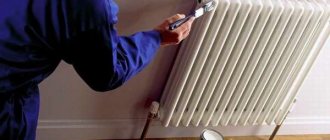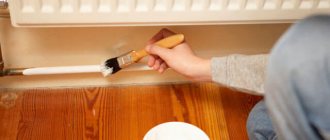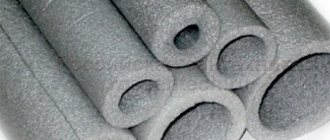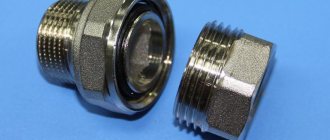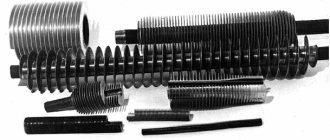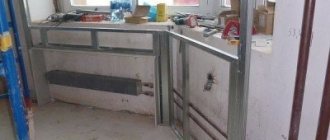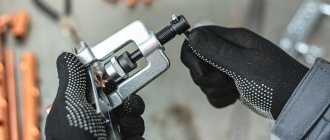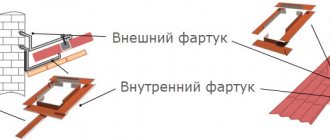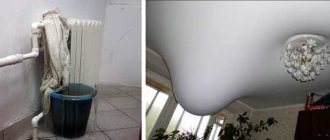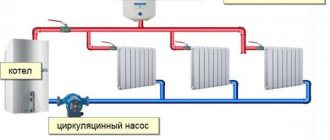Welcome!
Agree, peeling paint on batteries looks extremely unattractive. In addition, in places of chipping, the metal oxidizes over time and becomes covered with rust, which shortens the service life of iron heating devices. Paint for heating radiators available on the building materials market allows us to solve this problem. However, a wide range of radiators and enamels can confuse not only the common man.
We suggest you figure out which paints and varnishes can be used to paint batteries, as well as how to paint them correctly.
Can batteries be painted?
Self-painting of radiators is perceived by the manufacturer as a violation of the warranty conditions. But what to do if the warranty period has already expired? That's right, paint!
When painting, special attention is paid to the internal elements of certain types of radiators. For example, steel plates of convectors, the so-called comb or “ribs” strung on pipes, cannot be painted. An additional layer of paint will significantly reduce the level of heat transfer. Only the front flaps and screens are painted.
Painting works
Universal enamel PF-115
Most often, glyphthalic and pentaphthalic coatings are used for painting work on radiators. That is, the surface is primed with GF and coated with PF enamels.
The color range of the compositions most often suits all consumers, since the primers have several shades of gray, as well as red, blue and black. This is quite enough for all PF enamels.
And the service life here fully meets all the requirements - with proper painting, its shelf life will be at least 8-10 years, and in some cases even more, unless, of course, the requirements of the decoration are taken into account.
Paint for heating radiators
In addition to this, there are a number of other paintwork materials that can be used for painting work in such cases, for example:
- EMPIRE,
- TUTGUM
- AIPINA HEZKOROER,
- POLIFARB and so on.
But if you are wondering whether it is possible to paint batteries with acrylic paint, then pay attention to its heat resistance, which in such cases should be at the level of 95-100⁰. This is indicated in the instructions for the acrylic paint you see in the photo above.
What parameters should the paint meet?
To paint radiators and heating pipes, special paint and varnish compositions must be used that meet the operating conditions of the heating circuit. The following requirements apply to them:
- Heat resistance from 80⁰С and above. If the resistance to heat is insufficient, the paintwork will already turn yellow in the first heating season or change its original shade, crack and begin to peel off.
- High thermal conductivity. A low thermal conductivity index will lead to a decrease in heat transfer from the heating device.
- Anti-corrosion and moisture resistance. The main purpose of painting radiators is to protect them from the harmful effects of the environment and rust. To do this, the paintwork must not be porous.
- Resistant to abrasion and mechanical stress.
- Environmental friendliness and safety. The paint should not contain toxic substances, which evaporate especially actively when heating a house or apartment and thereby cause harm to human health.
- It is desirable that the paintwork for batteries is quick-drying and without a strong odor.
Brief overview of manufacturers
Heat-resistant paints and varnishes for painting heating systems, both imported and domestic, are available for sale. Both of them are quite suitable for painting batteries in a cottage or apartment.
Among the main manufacturing companies we can mention:
- Scandinavian TIKKURILA with the “Termal” series.
- German DUFA series “Thermo” and “Aqua-Heizkorperlack”.
- Russian TEX with special “enamel for radiators”.
- Polish SNIEZKA .
- Slovenian BELINKA .
- Russian LAKRA .
There are many options with different prices and composition, there is plenty to choose from. Moreover, when choosing a primer for paint, it is best to opt for products from one manufacturer. There is no point in experimenting with mixing what is cheaper.
An overview of popular thermal paints that are used for painting radiators, metal stoves and other elements of the heating circuit is given in this article.
Types and differences
There are a great variety of heat-resistant enamels on the market. To understand which one is best suited for your radiator, you need to focus not on the manufacturer, but on the basis of the paintwork. Not least important is the planned method of application and the decorative effect that you plan to get after painting.
Let us immediately note that we immediately exclude traditional oil paints from the review. Although some are marketed as heat resistant, in general they are not suitable for hot pipes.
Alkyd
The composition of alkyd heat-resistant paints includes alkyd varnish (glyphthalic or pentaphthalic), a solvent (most often white spirit), microfillers based on granite, sand or marble and coloring pigments. Some formulations can be supplemented with antiseptics that protect the painted surface from damage by fungus and mold.
- High hiding power allows the use of alkyd enamels both for basic painting and for creating a decorative pattern on top of the base coat.
- Elasticity ensures evenness and smoothness of the coating, and also prevents the effect of shrinkage.
- Resistance to abrasion, moisture, corrosion and temperature changes guarantees the durability of the coating.
- Color stability.
- High adhesion index to metal.
- Drying time – from 12 to 36 hours.
Disadvantages:
- Insufficient heat resistance. Designed for heating circuits with a heating temperature of no more than 80-100⁰С.
Organosilicon alkyd enamels with increased heat resistance (up to 600⁰C) are classified into a separate category. Organosilicon compounds are significantly more expensive than conventional alkyd compounds, but they are the ones used for painting fireplaces, chimneys and stoves.
- The specific pungent odor requires mandatory ventilation of the premises in which painting is carried out. The first heating of the pipeline will also be accompanied by the appearance of a pungent odor.
Important! Pay attention to the digital coding indicated on the label. “2” indicates the possibility of using the paint indoors, and “8” classifies it as heat-resistant.
Acrylic
Acrylic paints for radiators are a mixture of acrylate (acrylic polymer emulsion) with color pigment and water. The polymer coating is applied in an even, smooth layer and is not prone to smudges.
- Temperature maximum - 120⁰С.
- Without smell.
- Ultra-fast drying - from a few minutes to several hours.
A special advantage of acrylic enamel over analogues is that it can be applied even to a hot battery. This fact does not affect the quality of painting or the service life of the coating. Among the disadvantages is instability to mechanical abrasive wear.
Hammer
Hammer paint is a type of alkyd enamel based on a nitro-polymer with a dye. A distinctive feature is the decorative nature of the coating, which imitates a metal surface beaten with a hammer, while simultaneously hiding minor irregularities. Hence the name.
Additional advantages of using hammer paints will be:
- No pre-priming. The only obligatory condition is the mechanical cleaning of the metal from dust, while the active elements of the coloring composition can easily cope with grease stains and rust, simply dissolving them in themselves.
- Highest adhesion to metal surfaces. And during preliminary sanding, the paint eats into the metal structure so much that it can only be removed later by chemical means.
Water-based
Water-based (water-dispersed) paints are made from water, pigments and polymers. Depending on the type of binder base, they are divided into:
- Polyvinyl acetate (PVA);
- Polyacrylate.
PVA paints have low resistance to moisture, so they are definitely not suitable for batteries.
Polyacrylate is a subtype of acrylic enamels, which we described above.
Silicate
Silicate compositions are paintwork materials based on liquid potassium glass, ethyl silicate and powdered metal pigments. The presence of zinc and aluminum pigments gives the paint composition anti-corrosion properties.
Based on the type of binding component, silicate paints are:
- Organosilicon.
- Dispersed silicate. One-component compositions based on pure acrylate, ready for use.
- Silicate silicone. Two-component: separately - powder, separately - liquid glass, which are mixed before painting.
It is the presence of organosilicon resins in the composition that gives radiator enamels unsurpassed strength.
The undoubted advantage is fire resistance, and the disadvantage is high toxicity when painted.
Powder
Powder dyes are polymerized pigment powder, sprayed onto the surface to be painted in a special high-temperature box at a temperature of 170-350⁰C, where it melts and forms a reliable, durable coating.
Unfortunately, this painting technology is used only in factories and specialized auto repair shops, and is not available for DIY at home.
Aerosol
One alternative painting method is spray paint. Modern technologies allow almost any type of paint to be produced in aerosol cans. Among the presented assortment of aerosols, it is important to choose heat-resistant compounds; in extreme cases, auto enamels, which are initially designed for adhesion to metal and high temperatures.
Serebryanka
If you want to give the batteries a characteristic silver tint, you can use silver, prepared with your own hands from PAP-1 pigment aluminum powder and BT-577 bitumen varnish.
- The heat resistance coefficient of this coating with the correct component ratio reaches 300-400⁰С.
- Serebryanka is not subject to delamination, is resistant to corrosion and external influences. The coating will last at least 10 years.
- Dries quickly and is non-toxic.
On a note! Silver is not compatible with most other paints, and therefore requires complete cleaning of the surface to be painted from the remnants of the previous paintwork.
Matte
Matte coatings look respectable, especially on cast iron batteries with a textured pattern. But it is better not to choose matte white paints. The microporous structure is prone to dust accumulation, which means that white will soon acquire a gray tint.
Glossy
Gloss is ideal for batteries with a perfectly smooth surface, as well as for cast iron radiators, if the goal is to smooth out their characteristic roughness. In addition, the smooth texture is easy to care for; just wipe it with a soft damp cloth.
Selection criteria
There are quite a lot of requirements for all types of coatings for heating radiators. The paint must be resistant to high temperatures, at a level of 90-100°C, protect the metal from corrosion, adhere well to the surface, not change color over time and be non-toxic. Modern hardware stores offer a wide selection of paints and emulsions of all possible colors and shades. Most people are accustomed to the fact that a heating radiator should be white, but some strive to turn such an ordinary item into an original interior detail. After all, this beautifully painted object can become a highlight, a harmonious detail of any, even the most elaborate interior.
Some experts believe that color affects performance. Dark colors increase the heat transfer of the device, while light colors slightly reduce it. Now the choice of coatings is very large: there are separate products specifically for radiators; you can also use various enamels, heat-resistant varnishes, and water-based paints.
However, each type of coating has its pros and cons. So you need to carefully analyze everything before purchasing.
It is advisable that the heating be turned off at the time of painting work to avoid uneven drying of the surface, uneven application of the layer or loss of color. If for some reason this is not possible, you can use a coating that allows you to paint a warm surface.
Tips for choosing
- The enamel composition is supplemented with fine chalk or titanium dioxide. Chalk, unlike titanium dioxide, causes paint to change color. Give preference to titanium components.
- When choosing the right paint, pay attention to the markings. The inscription “For heating radiators” and the emphasis on compliance with GOSTs will ensure compliance of the technical parameters with the requirements outlined above. You should not choose products manufactured according to dubious specifications.
- Be guided by the mass of paint, and not the displacement. The greater the mass, the higher the hiding power index. Diluted enamel adds volume, but loses coverage.
Which paint to choose for aluminum or cast iron radiators
It should be noted that each type of metal has its own paint and painting technology:
- Cast iron is characterized by excellent adhesion to almost any type of enamels. In this case, you should be guided by the effect you want to achieve after coloring. Paint with a dense viscous structure will hide the rough texture, while light paint, on the contrary, will emphasize the effectiveness of cast iron.
- Aluminum and stainless steel are more capricious in choosing the appropriate paintwork. The painting technique used at the factory (powder coating and heat treatment) is practically not feasible at home. Therefore, priority is given to high-quality painting materials with a high adhesion coefficient - alkyd or acrylic. Some experts talk about the effectiveness of aerosol paints, moreover, applied to hot batteries.
Epoxy primers designed for treating metal before painting will help enhance the adhesion effect.
Approximate prices
| Brand | TEX | DUFA | Śnieżka | DULUX | Alpina | Lakra | KUDO |
| Manufacturer country | Russia | Germany | Poland | UK | Germany | Russia | Russia |
| The basis | Alkyd resin | Alkyd resin | Acrylic | Water-dispersed | Alkyd resin | Acrylic | Alkyd resin |
| View | Enamel | Enamel | Enamel | Enamel | Enamel | Enamel | Aerosol |
| Heat resistance, ⁰С | 100 | 120 | 80 | 90 | 110 | 100 | 80 |
| Drying time | 24 hours | 24 hours | 1 hour | 8 ocloc'k | 10 hours | 24 hours | 8 ocloc'k |
| Mass/volume | 550 g | 750 ml | 400 ml | 1 l | 750 ml | 2.4 kg | 360 ml |
| Price | 250 | 550 | 270 | 1000 | 650 | 590 | 200 |
Requirements for enamel
The main thing in choosing paint for a home heating radiator is its heat resistance. If the labeling of the can indicates that the composition has an operating temperature below +80°C, then you should not use such paintwork for painting the battery.
Conventional paint and varnish materials are not initially intended for painting heated elements of the heating system. After turning on the heating, they will begin to peel off or turn yellow.
The best paint for batteries is one whose label says “designed for heating radiators” and “quick-drying.”
The paint for painting the heating device yourself must be at the same time:
- heat-resistant – at least +80°С, and preferably +100°С;
- moisture-resistant and abrasion-resistant;
- non-toxic;
- with high thermal conductivity;
- quick-drying.
Due to inexperience, some choose ordinary non-heat-resistant paint for interiors for batteries. As a result, when heat is applied, it turns yellow or changes its original shade.
This is due to the presence of chalk or polymers in its composition, which are not designed for high temperatures. Therefore, both the binder material and the pigment must be heat resistant.
The paint on the battery is usually applied in two layers. The faster each of them dries, the faster the radiator will be ready for use. Moreover, often the faster the paintwork dries, the more pungent the odor of the composition.
So that the family is not forced to inhale these ambers, it is often easier to remove the heating device from the pipes and paint it somewhere in the garage or on the street.
Inexpensive chalk is often added to paint as a filler to reduce its cost; it is better to discard such paint and varnish immediately - such enamel will definitely turn yellow
When choosing between a glossy and matte option, you should remember that the slightest irregularities are noticeable on a shiny surface. For rough and lumpy cast iron batteries, it is better to choose a paint with a dull shade that will not produce glare from lighting.
Radiator cast iron often has metal streaks and chips. When using glossy enamel, all of them will definitely be visible.
At the same time, you should not be overly zealous in leveling the cast-iron surface of the battery with sandpaper before painting. This can lead to thinning of the radiator fin and the subsequent appearance of a fistula.
How to calculate paint consumption
On the labels, the manufacturer always indicates the average paint consumption per 1 m². Thus, determining the required amount of enamel is not difficult when it comes to flat radiator models. But here, too, we should not forget about painting the inside of the battery. With cast iron accordion radiators it’s even more complicated.
In this case, the technical documentation for heating devices will come to the rescue; it usually indicates the total area of the product. If the registration certificate has not been preserved, special online calculators are used.
Calculator
The online calculator takes into account all the parameters of the upcoming work:
- Battery model.
- Number of sections.
- Type of paint.
- The need to paint the pipeline.
- Estimated number of layers.
The program automatically produces the result in kilograms, taking into account a 10% reserve or the total surface area for painting, according to which you independently determine the required volume of product.
How to remove old paint
The basic rule for painting used radiators is to remove the old paintwork. You can perform this task in one of two ways (or in combination):
- Mechanically.
- Using chemical reagents.
For proper cleaning and subsequent painting, it is better to remove the battery from the wall.
Mechanical method
Mechanical cleaning involves removing old paintwork using handy means.
- First, the battery, and, if necessary, the pipe, is cleaned of dust and other contaminants with a damp cloth. For better results, you can use a vacuum cleaner.
- Then the surface is thoroughly sanded with sandpaper. The rust is completely removed. To speed up the process, use a drill with a brush attachment with stiff bristles or a grinder. To remove paint in hard-to-reach places, you can use a hair dryer; it heats up the enamel, which is then removed with a scraper.
- Finally, the working surface is again dusted and degreased.
Mechanical cleaning has many disadvantages:
- High labor and time costs.
- The process is quite dusty.
- There is a high probability of damage to the metal.
On a note! If the paintwork on the radiator shows no signs of wear (swelling, peeling, rusting), but still requires replacement, it does not need to be removed. To ensure adhesion to fresh enamel, it is enough to lightly sand the radiator coating.
Chemical means
For chemical cleaning, special preparations and removers are used. They soften the old coating and stimulate its peeling from the metal.
- They need to be applied in a dense, even layer using a brush with natural bristles. The gel form of the drug adheres well to the surface.
- After the time specified by the manufacturer, the wash is simply removed with a wooden spatula along with the dissolved paint, and the radiator is washed with soapy water.
- The cleaned battery is additionally treated with a corrosion inhibitor and then degreased.
On a note! Some manufacturers produce washes with a corrosion inhibitor already included in the composition. They cost a little more, but significantly reduce the time to prepare the radiator for painting.
It is important to remember that chemicals are toxic and flammable. Therefore, work must be performed in a well-ventilated area away from sources of fire. Personal protective equipment – a respirator, gloves and goggles – will also be useful.
How to paint heating radiators with your own hands
Preparing the Battery
Removing the old layer of paint is only the first preparatory stage. In the future, you should adhere to the following recommendations:
- Irregularities and roughness are smoothed out using metal putty. After it has set, the surface of the battery is cleaned again, dusted and degreased.
On a note! If you plan to paint with acrylic enamels, it is better to use acetone as a degreaser, and for alkyd compositions, white spirit or gasoline.
- The next step will be priming. The type of future coating is also taken into account. The basis of the paintwork and primer must be of the same type.
- Each coating (putty and primer) is dried naturally at room temperature.
Painting process
Staining is also carried out at room temperature. In this case, it is advisable to choose the period between heating seasons (before or after). Only some types of paints can be applied to a heated battery.
Painting is carried out in one of the following ways:
- By hand with a brush or roller.
It is better to choose brushes with soft bristles. This way the paint goes on smoother and splatters less. Painting the internal elements of a radiator with a regular brush, as a rule, does not give a good result. To ensure 100% coverage, special brushes are used, curved at a certain angle, with double-sided bristles, etc. (see photo).
- Using a spray gun or an aerosol can.
Compositions sprayed with a spray gun are pre-diluted by 10 percent with water or solvent (depending on the type of paint).
Whatever method you choose, you must adhere to the following rules:
- First, the inside of the radiator is painted.
- To avoid smudges, painting is done from top to bottom.
- It is better to apply the paint in a thin layer. Then it will dry better and not leak.
- Painting is done in 2-3 layers. The next layer is applied only after the previous one has completely dried.
- It is prohibited to paint over the air outlet of an automatic air vent. This blocks it from working.

